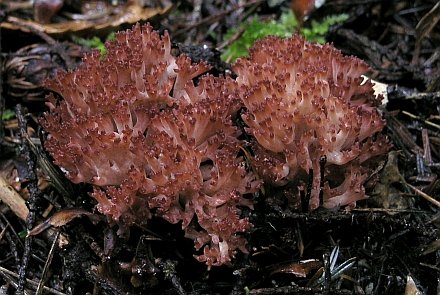The pink-tipped coral, Ramaria botrytis (Pers.) Ricken.
Synonyms
Clavaria botrytis Pers.
Comment. Fungis Clavaeform: 42 (1797)
Clavaria botrytis var. alba A. Pearson
Trans. Br. mycol. Soc. 29(4): 209 (1946)
Corallium botrytis (Pers.) Hahn
Pilzsammler: 72 (1883)
Common names
Cauliflower coral
Clustered coral
Pink-tipped coral
Rosso coral
Clavaire chou-fleur (French)
Hahnenkamm (German)
Druvfingersvamp (Swedish)
Houkitake (Japanese)
Description
Fruiting body: 10-12 cm diameter, 7-12 cm high, forming fleshy round masses with a short, stout base, densely branched above, white to buff, the tips of the branches reddish.
Smell: slight.
Taste: pleasant.
Stem: short, stout, white, tapering below, branching irregular, the primary branches few and stout (2-3 cm), ultimate branches slender (2-3 mm), more or less dichotomous.
Flesh: solid, white, brittle.
Spore print: dull yellow.
Spores: ellipsoid, entire in outline but with fine longitudinal or oblique striations often anastomosing, 11-17 x 4-6 µm. See spores here.
Habitat: on ground among leaves in woods; late summer to late autumn.
Edibility: edible, and for some, choice – especially if you’re a Katmandu native (Adhikari et al., 2005).
Description adapted from Burt, 1922.

My name is Austin Collins.
I've dedicated my life to Mushrooms.
I believe Mushrooms are the best kept secret when it comes to health and well being.
For that reason, I would like to share a company with you that in my opinion makes the best mushroom products on the market.
The company is called Noomadic Herbals, my favorite supplement they make is called "Mushroom Total".
I take their products every day and they have helped me think better and have more energy. Give them a try.
-Austin
Traditional use
Adhikari et al. (2005) report that in Kathmandu, this species is used medicinally to relieve muscle pain.
Bioactive compounds
A number of compounds have been isolated and identified from the fruiting bodies of Ramaria botrytis (Yaoita et al., 2007):
- a novel ceramide, (2S,2’R,3R,4E,8E)- N2′-hydroxyoctadecanoyl- 2-amino-9-methyl- 4,8-heptade-cadiene-1,3-diol
- 5α,6α-epoxy-3β-hydroxy-(22E)-ergosta-8(14),22-dien-7-one
- ergosterol peroxide (3), cerevisterol (4)
- 9α-hydroxycerevisterol
Ramaria botrytis was found to produce the unusual amino acid nicotianamine, an inhibitor of angiotensin I-converting enzyme (Izawa and Aoyagi, 2006).
The nutritional effects of alcohol extracts and acid hydrolysates of Ramaria botrytis were studied on the multiplication of tissue cells HeLa [human cervical carcinoma] cells; both the alcohol extracts and acid hydrolysate favorably infuenced maintenance of the normal form and monolayer of HeLa cells (Chung 1979).
Medicinal properties
One study demonstrated that the methanol extract of R. botrytis had a protective effect on liver damage in benzo(a)pyrene-treated mice. The activities of marker liver enzymes serum aminotransferase, cytochrome P-450, aminopyrine N-demethylase, aniline hydroxylase and hepatic content of lipid peroxide after benzo(a)pyrene-treatment were increased relative to the control, but those levels were significantly decreased by the treatment of methanol extract, whereas the hepatic glutathione content and activities of glutathione S-transferase and r-glutamylcysteine synthetase were increased by the treatment of R. botrytis methanol extract. Also, the cytochrome P-450 1A1 isozyme protein level, increased by benzo(a)pyrene-treatment, was decreased by the treatment with methanol extract. The authors suggest that the protective effect of the R. botrytis methanol extract on liver injury may be due to reduction of oxygen free radicals (Kim and Lee, 2003).
Polysaccharides extracted from the mycelial culture of R. botrytis and administered intraperitoneally into white mice at a dosage of 300 mg/kg inhibited the growth of Sarcoma 180 and Ehrlich solid cancers by 60% (Ohtsuka et al., 1973).
Links
Mycoweb, Mushroom Expert have additional information. This website about the fungi of Thrace, Greece has an impressive photo gallery, as does the Swedish Stridvall site.
References
Adhikari MK, Devkota S, Tiwari RD.
Ethnomycological knowledge on uses of wild mushrooms in western and central Nepal.
Our Nature. 2005 3:13-19.
PDF available online
Burt EA.
The North American species of Clavaria with illustrations of the type specimens
Annals of the Missouri Botanical Garden. 1922 9(1):1-78.
Chung KS.
The effects of mushroom components on the proliferation of HELA cell line in vitro.
Arch Pharm Res. 1979 2(1):25-34.
Izawa H, Aoyagi Y.
Inhibition of angiotensin converting enzyme by mushroom.
J Jap Soc Food Sci Technol. 2006 53(9):459-65.
Jarvis MC, Miller AM, Sheahan J, Ploetz K, Ploetz J, Watson RR, Palma Ruiz M, Pascario Villapan C, Garcia Alvarado J, Lopez Ramirez A, Orr B.
Edible wild mushrooms of the Cofre de Perote region, Veracruz, Mexico: An ethnomycological study of common names and uses.
Econ Bot. 2004 58:S111-S115.
Kim HJ, Lee KR.
Effect of Ramaria botrytis methanol extract on antioxidant enzyme activities in benzo(α)pyrene-treated mice.
Korean J Food Sci Technol. 2003 354: 286-290.
Ohtsuka S, Ueno S, Yoshikumi C, Hirose F, Ohmura Y, Wada T, Fujii T, Takahashi E.
Polysaccharides having an anticarcinogenic effect and a method of producing them from species of Basidiomycetes.
UK Patent 1331513, 26 September 1973.
Yaoita Y, Satoh Y, Kikuchi M.
A new ceramide from Ramaria botrytis (Pers.) Ricken.
J Nat Med. 2007 61(2):205-7.




